Skating on Swan Lake
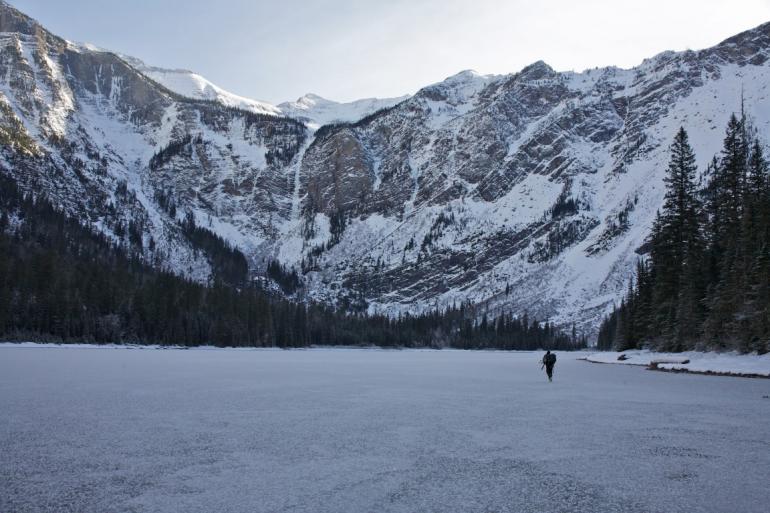
Photo by Kay Bjork
Sitting on the lakeshore, I tug on my skates—rushing like an impatient child, in part because of the frigid air, but also because of my excitement for the first skate of the season. Navy blue ice lies before me, inviting and at the same time intimidating—like placing the first brush stroke on an empty canvas. I take a quick step onto the flawless ice and glide effortlessly on the glass-like surface where I can see the bottom of the lake. Startled fish startle me as they dart away reminding me of the explosion of sparks when a log is added to a fire. I am lulled by the sound of my skates as I leave a trail of thin white lines—the beginning of my ice skating sketch.
Skating on wild ice is truly a spiritual experience. The sensation of gliding along a frozen lake can be like flying. An experience that is surreal, exhilarating, uplifting and at times—frightening.
For me, even though I grew up skating on the numerous rinks in northern Minnesota, my love for ice skating did not begin until our fortunate and very intentional landing on Swan Lake, in northwest Montana. Here we built a house, a family and a very unique life centered on the intriguing process of going through four seasons at the lake—which included winter.
Until then I was indifferent to the idea of ice skating, in places where I was literally boxed in and skating in circles with a large group of people. But then I discovered wild ice. Ice without refrigeration, Zambonis and sideboards. Here your spirit could soar with your skates.

Photo by Kay Bjork
One of my first experiences was on extraordinary ice. An extended cold snap caused the entire lake to freeze. I held my breath, waiting to see if the ice would grow thick enough before it snowed and buried the ice and our hopes for an epic skating adventure. The temperatures plunged and the ice gained over an inch overnight to nearly four inches. I was still taking bites of toast as we bundled up, grabbed our skates and set out to explore this new playground.
Excitement, awe and the slap of cold air took my breath away. When I slid onto the frozen lake it felt like air. By the time my husband Dewey had his skates tied, our daughters Risa and Kelsey had filled the ice in front of our home with skate scribbles, like doodles on an etch-a-sketch. It was a bluebird and windless day—a perfect ice skating day. We headed up the lake, which stretches south of our home for almost ten miles.
Skating on the smooth quick ice felt effortless as we flew down the frozen lake. The lake was almost silent except for the scrape of skates on the hard surface. We all fell into an almost Zen-like state as we were lulled by the rhythm of ice skating.
A skating adventure also includes a treasure hunt, searching for nature’s artwork with ice and snow as her canvas. We saw little ice crystals dripping from a log on the shore. Pressure cracks in the ice captured sunlight and revealed the depth of the ice. We observed rocks along the shore that look like glazed donuts, frosted by the lap of waves before the lake became frozen.

Photo by Kay Bjork
Less than an hour later we reached the end of the lake, where we noticed open water at the inlet. We straddled a log tipped into the frozen lake and soaked up the sunshine, which softened the wintry air. Snacking on our family’s trademark “hundred-mile-an-hour” cookies, we spotted an eagle in a nearby snag.
We turned around to head home, warmed by the sunshine, the constant movement and an experience we would remember forever.
These moments are priceless in their rarity and unpredictability. Wild ice is fickle and fleeting. We have learned the art of chasing great ice, which is dependent on attentive weather watching combined with the willingness to drop everything when a cold snap transforms our watery playground into a field of ice.
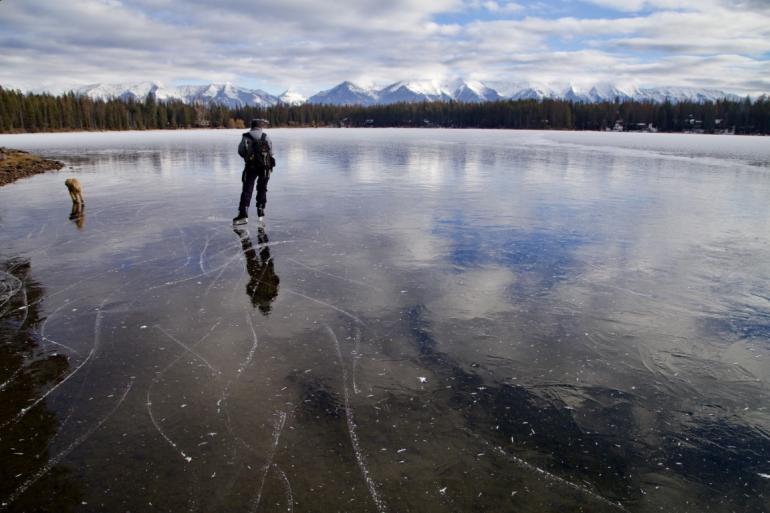
Photo by Kay Bjork
Even though clear, smooth ice is the ultimate, the simple thrill of playing outside in this transitory world is enough to draw us onto ice of varied conditions. A light dusting slows down our skates, but as long as we can still evaluate the strength and thickness of the ice, it can still pass as a great skate. Drifts of snow along with ice heaves and pressure cracks turn our gigantic ice rink into an obstacle course, but it also makes you a better skater.
Sometimes we are able to prolong our ice skating season even after a snowfall. Armed with our shovels, we clear a rink that conveniently has snowy sideboards for a game of hockey or a skate in the first light of the day before the school bus arrives to pick up our daughters. But that too can be short-lived as the weight of the snow causes the water below to seep to the surface and our rink turns to slush.
Winter is not always silent. Lake ice has its own language, its own music that will stop you in your tracks day or night. The winter song starts when the ice expands and contracts, triggering a series of pops and crackling, and then it turns into something more melodic as the sound vibrates like the pluck of a cello string or a thump on an enormous timpani drum. The ethereal sound is hauntingly beautiful, as the lake comes alive to serenade those who will stop and listen—to hear and feel the voice of the natural world.
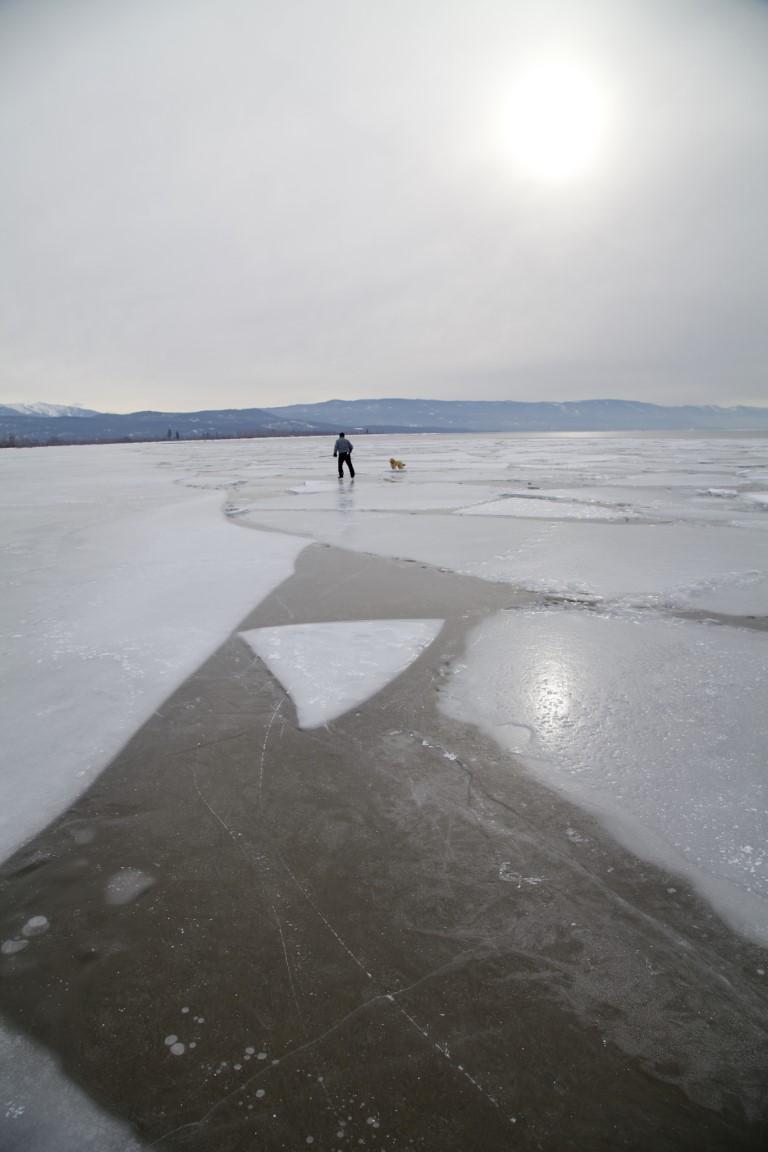
Photo by Kay Bjork









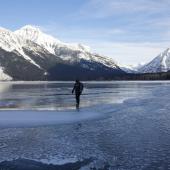
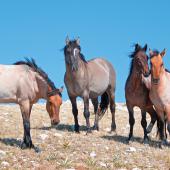

Leave a Comment Here